
A crowd of West Berliners gathers at the newly erected Berlin Wall while an East German soldier patrols on the other side in August 1961
The Berlin Wall’s story began in the early hours of August 13th, 1961, when the government of East Germany ordered the closure of all borders between East and West Berlin. As the sun rose that morning, Berliners were awoken by the sound of trucks, jackhammers, and other heavy machinery.
Watched by Soviet troops and East German police, workmen began breaking up roads, footpaths, and other structures, before laying thousands of meters of temporary but impassable fencing, barricades, and barbed wire.
They worked for several days, completely surrounding the western zones of Berlin and cutting them off from the city’s eastern sectors.
Berliners were in shock. “A concentration camp barrier” has been stretched through the center of Berlin, said then mayor – and later chancellor – Willy Brandt a few hours later in front of the city’s parliament.
The Berlin Wall would remain for exactly 10,315 days, becoming a symbol of the Cold War and dividing the world into two hostile blocs: the capitalist West and the communist East.
The wall became a stark and foreboding symbol of the Cold War. In the West, its presence was exploited as propaganda. The Berlin Wall, Western leaders said, was evidence that East Germany was a failing state, that thousands of its people did not want to live under communism. US Secretary of State Dean Rusk called the Wall “a monument to communist failure” while West German mayor Willy Brandt called it “the wall of shame”.
In Washington, there was considerable debate about how the US should respond to the erection of the Berlin Wall. Ever the realist, President Kennedy knew that threats or shows of aggression might provoke confrontation or lead to war. He instead focused his attention on West Berlin, hailing it as a small but determined bastion of freedom, locked inside an imprisoned state.

East German soldiers, left, set up barbed-wire barricades at the border separating East and West Berlin on August 13, 1961. West Berlin citizens, right, watch the work.
Kennedy visited West Berlin in June 1963 and was greeted by ecstatic crowds, which cheered wildly and showered his motorcade with flowers and confetti.
In the Rudolph Wilde Platz (later renamed the John F. Kennedy Platz), the US president told a rapt audience: “There are many people in the world who really don’t understand, or say they don’t, what is the great issue between the free world and the Communist world. Let them come to Berlin. There are some who say that communism is the wave of the future.
Let them come to Berlin. And there are some who say in Europe and elsewhere we can work with the Communists. Let them come to Berlin. And there are even a few who say that it is true that communism is an evil system, but it permits us to make economic progress. ‘Lass sie nach Berlin kommen’: let them come to Berlin…
Freedom is indivisible, and when one man is enslaved, all men are not free… All free men, wherever they may live, are citizens of Berlin, and therefore, as a free man, I take pride in the words: ‘Ich bin ein Berliner’ (I am a citizen of Berlin).”

A young East Berliner works on a concrete wall that was later topped by barbed wire at a sector border in the divided city on August 18, 1961. People’s Police stand guard in the background as another worker mixes cement.
Improvements on the Wall continued until 1980 when the entire wall had been converted to reinforced concrete sections which were 12 feet high and 4 feet wide each.
On top of the wall was barbed wire in addition to watchtowers manned with soldiers having machine guns. By the 1980s, the wall had extended 28 miles through Berlin and covered 75 miles around West Berlin. There were extensive barriers along the border of East and West Germany that covered 850 miles.
The demolition of the Berlin Wall began on the evening of November 9, 1989. Over the following weeks, citizens of East Germany began using varied tools to demolish parts of the wall creating unofficial crossing points.
Soon afterward the government of East Germany demolished sections of the wall to create ten official crossing points, and by December 22, 1989, it allowed visa-free travel on both sides of the wall.
On June 13, 1990, East Germany’s army began official demolition of the wall and completed the job in November 1991 signaling the official reunification of Germany.
During the 28 years, it stood, only about 5,000 people managed to cross over the wall, escaping into West Berlin. More than 100 are believed to have been killed in the attempt, most shot by East German border guards.

Under the eye of a Communist “People’s Policeman,” East Berlin workers with a power shovel destroy one of a number of cottages and single-family houses along a sparsely settled stretch of the east-west Berlin boundary in October 1961.

Tracks of the Berlin elevated railroad stop at the border of the American sector of Berlin in this air view on August 26, 1961. Beyond the fence, the Communist-ruled East Berlin side, the tracks have been removed.
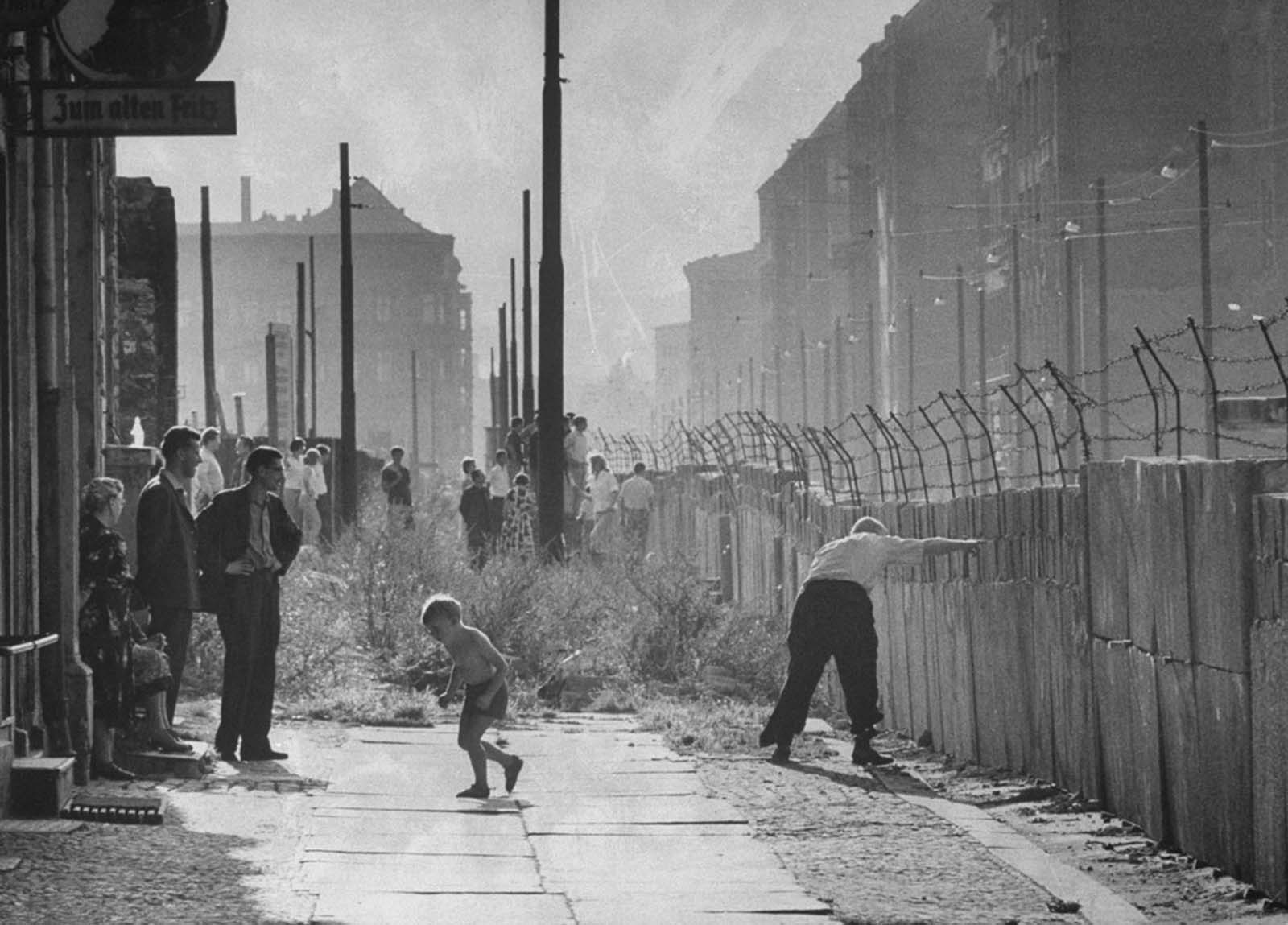
West Berliners gather near the newly built Berlin Wall in August 1961.

West Berliners, angered by taunts from East Berlin Police, throw rocks in August 1961.

West Germans peer over part of the newly constructed Berlin Wall while waiting for relatives to return from the eastern sector in August 1961.

Workers set up a sign warning pedestrians they are leaving the American sector of Berlin, Germany, on Wiener Strasse (Vienna Street) in the district of Kreuzberg in West Berlin, on August 13, 1961. In the background is the Berlin Wall that divides East and West Berlin.
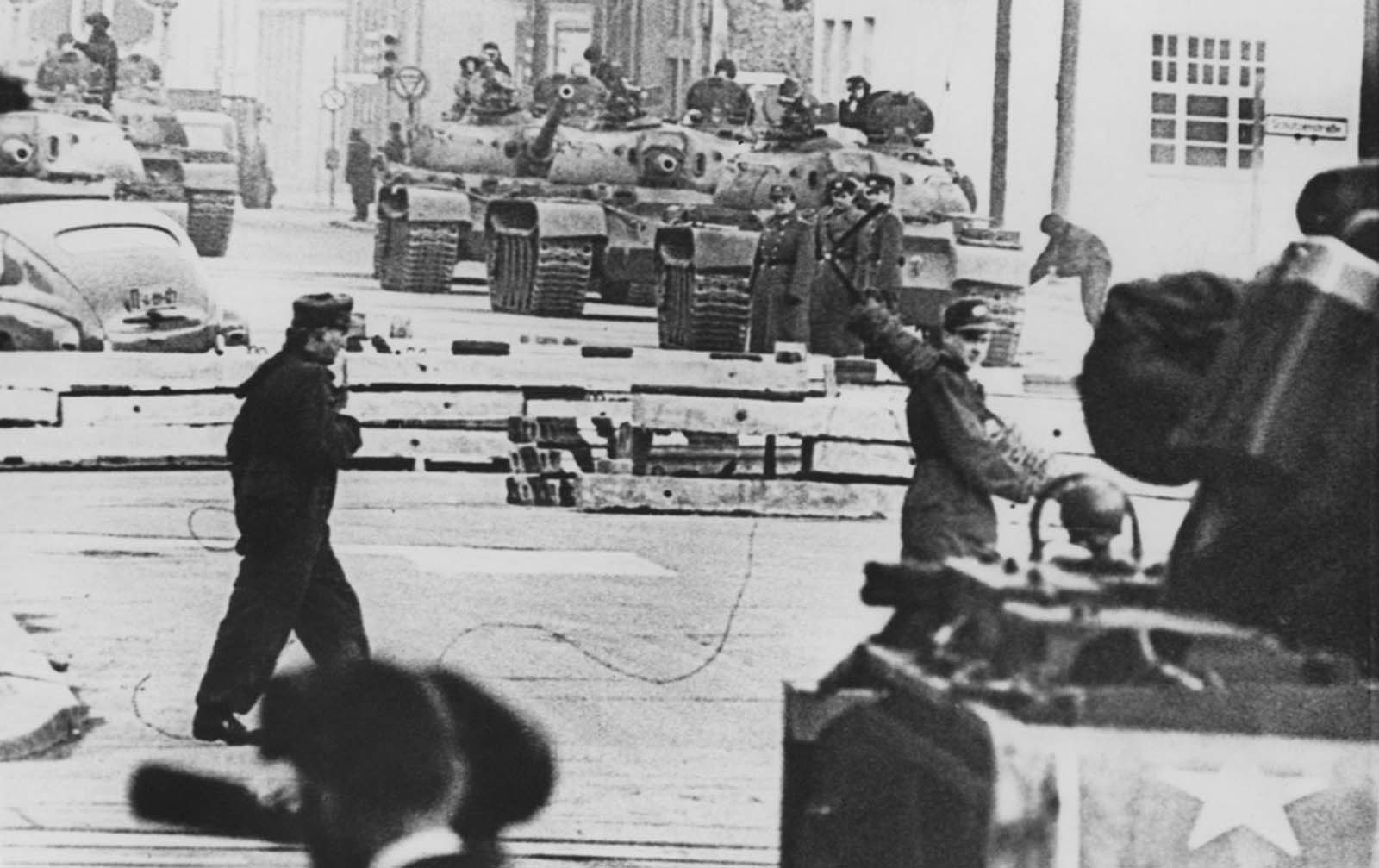
Russian (background) and American (foreground) tanks face each other at the Friedrichstrasse checkpoint in Berlin during the construction of the Berlin Wall on October 28, 1961.

Barbed wire on the west side of the Brandenburg gate, put up as a “safety measure” by the British, photographed in November 1961.

Friends reach across the barrier to touch each other in August 1961.

Communist People’s Police officers string barbed wire along a fence between East and West Berlin in September 1961.

A young girl gazes pensively through the pane of her apartment window, which reflects the image of barbed wire fencing that tops the nearby Berlin Wall, in December 1962.
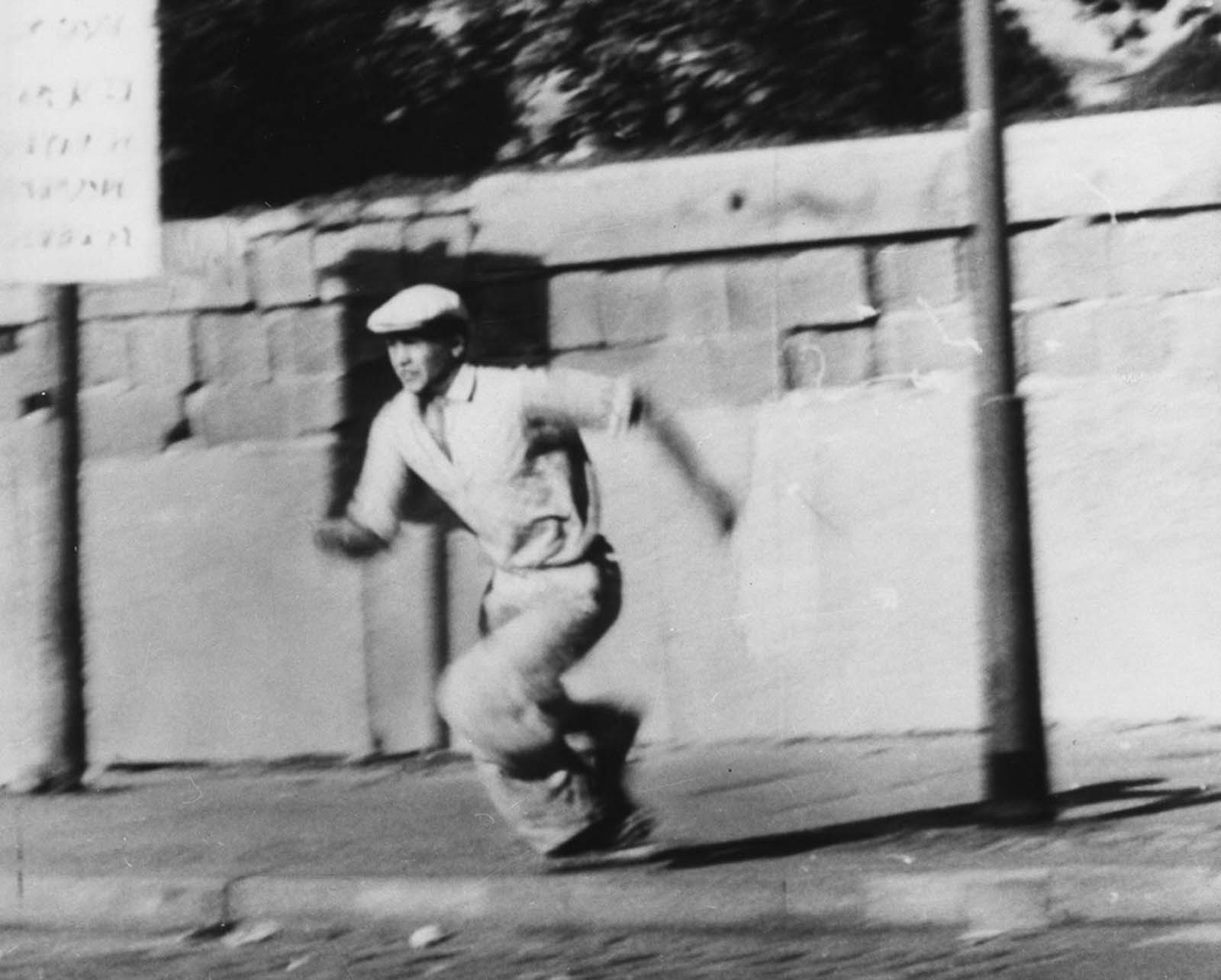
A refugee runs during an attempt to escape from the East German part of Berlin to West Berlin by climbing over the Berlin Wall on October 16, 1961.

An East German VOPO (Volkspolizei) border policeman uses binoculars while standing guard on one of the bridges linking East and West Berlin, in 1961.
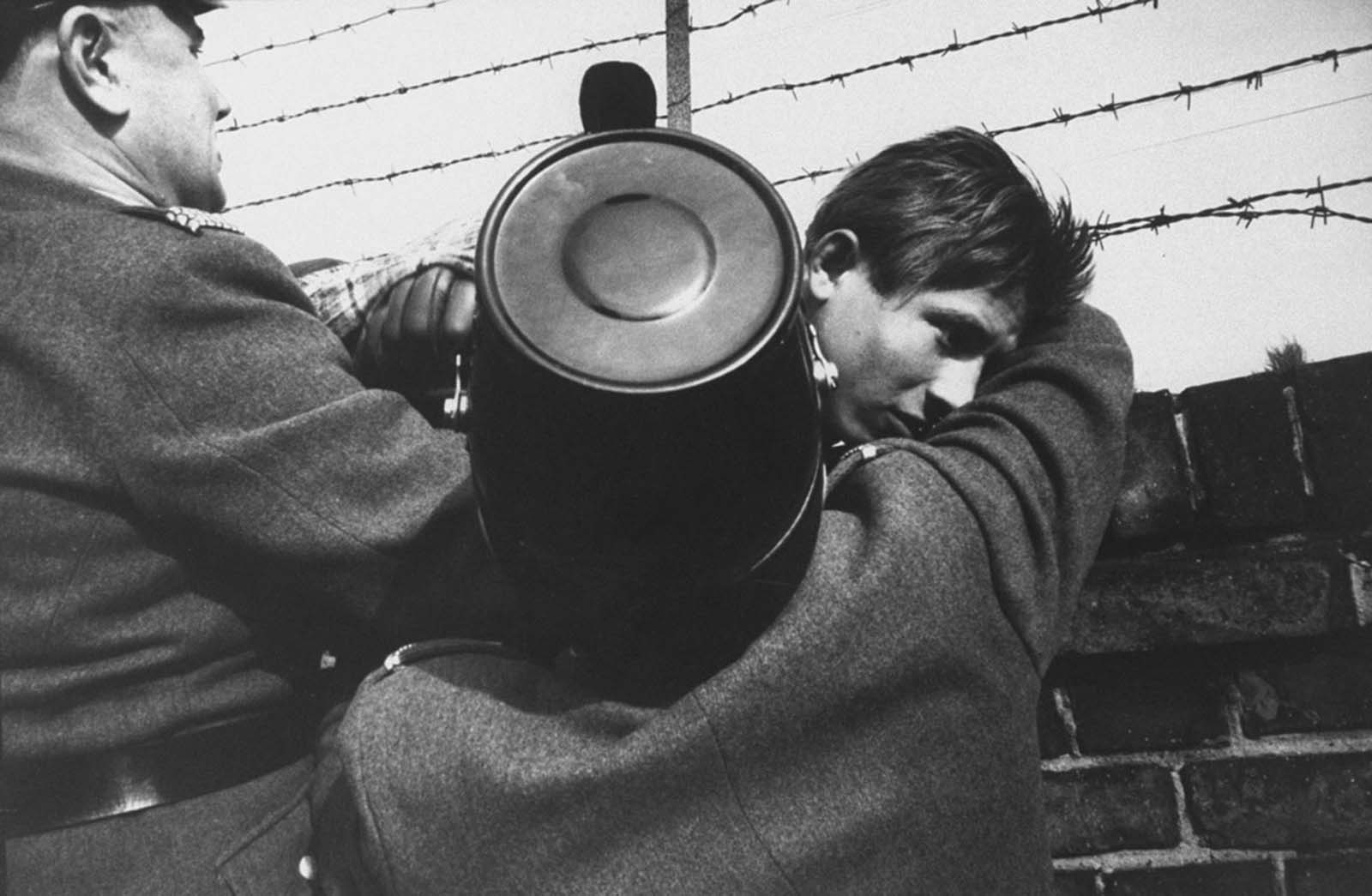
A 17-year-old East Berlin youth is helped down from the Berlin Wall by two friendly West Berlin police officers after he climbed over to freedom in October 1961.
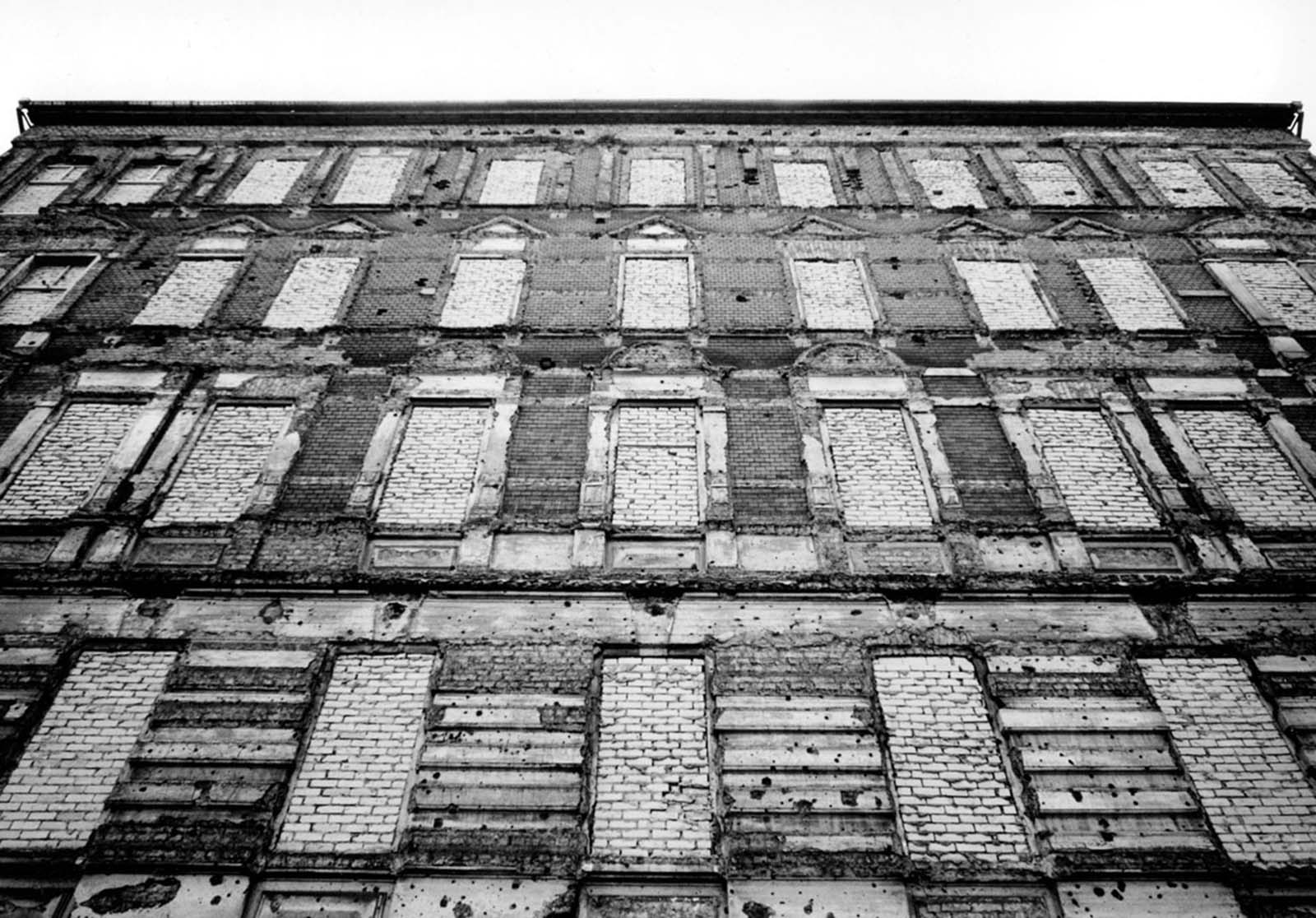
After East Germans jumped to freedom in the West, the windows of this building on the eastern side of the wall were bricked over. The building was later demolished. Photographed in 1962.

One of six West Berliners who dug a 20-inch-wide tunnel under a border street to East Berlin crawls out sometime over the weekend of June 8–10, 1962. Sixteen East Berliners, relatives of the diggers, came through the tunnel dragging an infant behind them in a wash basin. The tunnel was believed to have been discovered in early June 12, a few hours after the 17 reached the West.

A 75-year-old woman is helped into Tunnel 57, through which 57 East Berlin citizens escaped to the western sector of the city on October 3 and 4, 1964. The tunnel was dug from West to East by a group of 20 students led by Joachim Neumann, from a disused bakery building on Bernauer Strasse, under the Berlin Wall, to a building 145 meters away on Strelitzer Strasse in East Berlin.

Original caption: “To give the impression of normality, East German authorities sent children to the base of the Berlin Wall to act as if they were at play. Berlin, 1962.”

A dying Peter Fechter is carried away by East German border guards who shot him down when he tried to flee to the West in this August 17, 1962, photo. Fechter was lying in no-man’s-land for 50 minutes before he was taken to a hospital, where he died shortly after his arrival.

President John F. Kennedy stands before a huge crowd in West Berlin on June 26, 1963. Here he made his famous declaration: “Ich bin ein Berliner,” and pledged support to West Berlin against Communist threats.

Thousands of people line up at the Schillerstrasse in Charlottenburg, Berlin, to apply for a passage slip to get across the border on December 19, 1963.

A photograph taken on August 10, 1966, of the system of walls, barriers, watchtowers, and an open “death strip,” along the border separating East and West Berlin, looking toward the Brandenburg Gate, as seen from the German Reichstag Building.

East German border guards carry away a refugee who was wounded by East German machine-gun fire as he dashed through Communist border installations toward the Berlin Wall in 1971.

U.S. President Ronald Reagan visits the Berlin Wall with German Chancellor Helmut Kohl (left), in June 1987.

In this photo taken on August 11, 1988, the year before the Berlin Wall came down, a message is seen painted on the wall at Potsdamer Platz: “Berlin will be wall-free.” A little more than a year later, on November 9, 1989, the wall finally came down.
(Photo credit: The LIFE Picture Collection).
Updated on: December 8, 2021
Any factual error or typo? Let us know.



